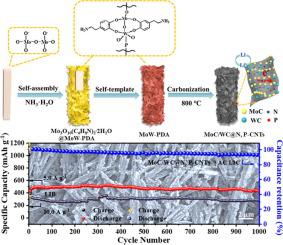Journal of Colloid and Interface Science ( IF 9.9 ) Pub Date : 2021-09-04 , DOI: 10.1016/j.jcis.2021.09.010 Zhixiao Zhu 1 , Zejun Zhao 1 , Xiaobing Bao 1 , Teng Wang 1 , Yifan Qin 1 , Xiufu Hua 2 , Yong Yang 1

|
Metallic carbides demonstrated tremendous application potential in energy conversion field deriving from their distinctive electrochemical activity and chemical stability. Herein, a molybdenum-based hybrid self-template strategy was adopted to confine ultrafine molybdenum carbides and tungsten carbides nanoparticles in N, P-codoped carbon nanotubes (MoC/WC@N, P-CNTs) for enhanced lithium-ion storage. Specifically, hierarchical MoW-polydopamine nanotubes were prepared via a self-template strategy, which employed Mo3O10(C6H8N)2·2H2O nanowires as the template. Ultrafine MoC and WC nanoparticles embedded in ultrathin carbon nanosheets could be obtained rationally after carbonization treatment, which could not only prevent carbides nanoparticles from agglomeration and oxidation, but also endow the rapid electron transfer rate. Thus, MoC/WC@N, P-CNTs displayed outstanding lithium storage abilities with great rate property and long-term cycling durability. The stable specific capacity of 475.0 mAh g−1 could be preserved at high current intensity of 5.0 A g−1 after 1000 cycles, which was one of the best performances for metal carbides anodes. Furthermore, the successful fabrication of lithium-ion hybrid capacitors (LIHCs) delivered the maximum energy density of 117 Wh kg−1 and power density of 6571 W kg−1. Moreover, the superior capacity retention of 89.7 % after 2000 cycles also indicated the excellent cycling stability. The present work highlights a self-template strategy for designing nanostructures toward efficient energy storage and conversion fields.
中文翻译:

通过超细双金属碳化物纳米粒子与类空心碳复合材料提高锂离子存储性能
金属碳化物因其独特的电化学活性和化学稳定性而在能量转换领域显示出巨大的应用潜力。在此,采用基于钼的混合自模板策略将超细碳化钼和碳化钨纳米粒子限制在 N、P 共掺杂的碳纳米管(MoC/WC@N、P-CNTs)中,以增强锂离子存储。具体而言,通过自模板策略制备了分层 MoW-聚多巴胺纳米管,该策略采用 Mo 3 O 10 (C 6 H 8 N) 2 ·2H 2O 纳米线作为模板。碳化处理后可以合理地获得嵌入超薄碳纳米片中的超细MoC和WC纳米粒子,不仅可以防止碳化物纳米粒子团聚和氧化,而且具有快速的电子转移速率。因此,MoC/WC@N、P-CNTs 表现出优异的锂存储能力、优异的倍率性能和长期循环耐久性。475.0 mAh g -1的稳定比容量可在 5.0 A g -1 的高电流强度下在 1000 次循环后保持,这是金属碳化物负极的最佳性能之一。此外,锂离子混合电容器 (LIHC) 的成功制造提供了 117 Wh kg -1的最大能量密度和 6571 W kg -1 的功率密度。此外,2000次循环后89.7%的优异容量保持率也表明其优异的循环稳定性。目前的工作强调了一种自模板策略,用于设计纳米结构以实现高效的能量存储和转换领域。



























 京公网安备 11010802027423号
京公网安备 11010802027423号